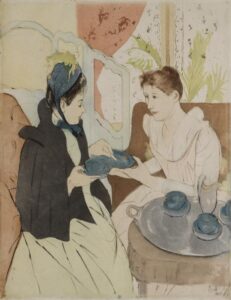Today’s post comes from Simone Levine, class of 2013 and Art Center Student Docent.

The past three Thursdays this July, Director Mark Lindberg and the Powerhouse Apprentice Company presented “The After Gallery” during Late Night at the Frances Lehman Loeb Art Center. In the performances, Lindberg employed the technique of Soundpainting by appropriating its language of gestures. First conceived by composer Walker Thompson in 1974, Soundpainting features a conductor who orchestrates an assembly of performers. The performers are grouped by the sounds, movements, and other effects that they are assigned to elicit according to the conductor’s gestures. However, in “The After Gallery,” Lindberg broke up the orchestra into a series of duets between painters (who use Thompson’s conductor’s language of gestures) and their partners (who play the role of puppets for their painters). I first learned about Soundpainting through a friend I met in a dance theater class at Vassar and after attending “The After Gallery,” I was intrigued by how Lindberg’s choice to revise Thompson’s original composition augmented the dimension of Soundpainting’s performance space.
“The After Gallery” began while the audience was still enjoying cheese and crackers in the Art Center’s atrium. A hush fell over the group as the performers processed down the staircase, through the visitors, and into the galleries. Visitors followed the performers and gathered around them as they assumed their positions for the start of their performance in the gallery. One performer stood opposite a line of other performers, all dressed in black, quirky-yet-pedestrian costumes that reflected the personality of each character. Another line of performers, each also dressed in black, stood against along a wall of the gallery. The solitary performer facing the line soon beckoned to a performer opposite him who carried a guitar; he then began to articulate gestures toward the guitar player, who responded by plucking the strings of his instrument according to the tempo his puppeteer delivered. I expected the single performer to engage with other performers along the line facing him (as the conductor of Thompson’s Soundpainting would), but to my surprise the duet moved away from the audience and the other performers, into an adjacent gallery where they continued their exchange. Another performer stepped away from the wall to face the line and picked her partner from it, and the two began their exchange—the first making gestures and the second responding (this time with anxious whimpering). These two soon moved away from our assembly into a new gallery, and one-by-one the partnerships formed between the remaining performers. The audience soon split up, choosing to follow the various partnerships into their various galleries. While roaming the galleries one could overhear the activity between partnerships in neighboring galleries. I observed many partnerships interacting with each other (as the black-clad performers directed their partners through exchanges with other puppeted performers and through reactions to the works of art around them). Toward the end of the performance, the partnerships drifted back into a central gallery and together produced a song as the performers instructing their partners to make sounds (or, in the guitar player’s case, play his instrument).
By splitting up the performers into a series of partnerships, Lindberg liberated his Soundpainting performance from simply what was within reach of Thompson’s singular conductor, freeing his performance to spread across the entire space of the Art Center’s galleries. Moreover, in giving the audience no choice but to follow the performers, Lindberg broke with the traditional territory of separate spaces for performers and audience members. “The After Gallery” provided a refreshingly interactive experience as the performers’ led the audience on an unexpected exploration of the art galleries and entertained us with the strange exchanges between the characters and their puppeteers.





I love the Loeb!!!